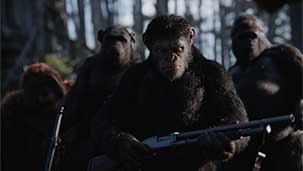The Great Apes—orangutans, gorillas (both Eastern and Western) bonobos, chimpanzees—all share about 97-99% of genetic material with their human cousins. Even when we correct for the inevitable anthropomorphizing, it’s clear that we are all closely linked physically, and perhaps behaviourally.
I’m not going to bury the lede here. This is a great film. One of the best of its kind (big budget tent-pole summer fare) I’ve ever seen. War for the Planet of the Apes is almost flawless, given its goals. It is entertaining, thoughtful, surprisingly nuanced, and filled with moments that stick.
Essentially a re-iteration of the Moses-leads-his-people-from bondage tale, War is the last of the trilogy that began with Rise and then Dawn of the Planet of the Apes. As with the other two, it traces the gradual, but violent, replacement of man by his primate cousins (led by Andy Serkis’s Caesar) in a near future Apocalypse.
And while the movie more than lives up to its title—there are several combat sequences that manage the tricky balance of being both thrilling and repulsive—it is far more than a series of skilfully orchestrated battle scenes stitched together by an otherwise threadbare plot. War is a complete film, filled with thoughtful moral ambiguity, fully fleshed-out (if sometimes a little elevated) characters and a story that is coherent and completely engaging on an emotional level.
One of the reasons why all of the newest crop of Ape movies have been so affecting is the artistry you and your team have displayed. Part of that is down to rapidly improving technology and the ability to delineate each individual hair, each fold of primate skin, so convincingly that there is no disconnect between the living and the purely animated. But the art is in how that technology is perfectly integrated into a story that is emotionally compelling.
Much of what usually prevents films that mix CG and live action from landing completely can be laid at the feet of an effect called "The Uncanny Valley". This creates an emotional distance in the audience. A sense that what we are watching is somehow wrong. It serves to constantly pull us out of the world the film is spending time and treasure to get us to accept.
War bridges that chasm with a clever trick—the Ape characters are the audience surrogates. They are so convincingly depicted, with a range of emotions that encompass grief, rage, sympathy, compassion, joy and one scene of disturbing empathy, that it is impossible not to be drawn into their story. The reason audiences usually sense the wrongness of CG depictions of humans is because we are so attuned to human facial features and what they should do. As a result any discrepancy in their depictions, no matter how minute, registers somewhere in our subconscious as wrong. You leap frog that problem by guiding our sympathies towards characters that, while almost human, are sufficiently unfamiliar in detail that we comprehend the broad strokes—an eyebrow lift, a pursing of the lips—while remaining completely unconcerned with whatever slight mischaracterisations that may exist.
That allegorical sleight of hand is made even more effective by the nuance and subtlety of the performances that integrate your wizardry and the impressive physicality of the mo-cap actors. And since most of the mo-cap characters don’t speak, their facial expressions and body posture become even more pivotal. It’s hard to overemphasize how completely you succeeded. There was no point where my subconscious pinged me "oh hey whoa, that ain’t right". In fact, it wasn’t until after War was over that I even realized that was the case, so complete was the illusion. That’s some goddamn magic right there.
War for the Planet of the Apes deserves all the praise it is likely to receive.
Sincerely,

Tim







